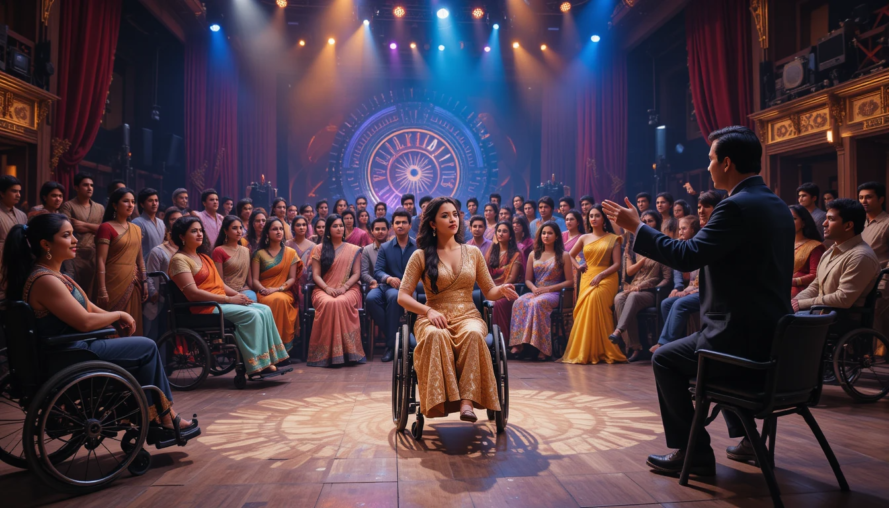Last week we took to the example of Ravindra Jain, the Maestro who was visually impaired and handicapped. His example can bring inspiration to many, but real problem lies in the mindset of people perceiving them as weak and needy. The underrepresentation and lack of opportunities for disabled individuals in Bollywood is a significant issue. To address this morally and ethically, the industry and society must adopt a more inclusive approach. Here are some possible solutions:
Equal Chances for Everyone
The film and music sectors ought to focus on employing professionals for their skills instead of their physical capabilities. Skill, imagination, and dedication are what genuinely characterize an artist, and these ought to be the main standards for choice. Regrettably, numerous talented people with disabilities face difficulties in securing jobs due to the absence of inclusive hiring practices in the industry. Casting directors, music producers, and production companies need to make concerted efforts to adopt more equitable hiring practices.
A key method to guarantee equitable opportunities is by instituting quotas for disabled actors, directors, writers, and technicians. By reserving a specific percentage of positions for people with disabilities, the sector can assist in disrupting the cycle of exclusion. Nevertheless, inclusion shouldn’t merely be procedural; emotional inclusion holds equal significance. Establishing a workplace where disabled individuals feel appreciated and at ease is equally important as offering them opportunities. By promoting respectful dialogue and removing any feelings of exclusion, Bollywood should aim to build a genuinely inclusive industry.
Open Infrastructure
If Bollywood genuinely starts to acknowledge and welcome disabled talent, it should also create a system that facilitates their involvement in the industry. In the absence of appropriate physical arrangements, individuals with disabilities find it challenging to perform their jobs effectively and comfortably.
Studios, recording booths, and film sets must have ramps, accessible seating, assistive technology, and additional essential facilities to support individuals with physical disabilities. Through these modifications, the sector will ensure that disabled workers have access, while also motivating others to step forward without worrying about logistical issues.
Another important factor is transportation. Numerous disabled artists struggle to participate in auditions, shoots, and industry gatherings because of insufficient accessible transportation. The movie industry ought to offer dedicated transportation options to assist
Shifting Perception
In Bollywood, able-bodied actors frequently portray disabled characters. Although these performances might receive acclaim for their emotional richness, they deprive genuine disabled actors of opportunities to portray these roles with authenticity. This behavior is not just unjust but also conveys the idea that the industry lacks faith in the capabilities of disabled actors. If a character has a disability, the part should be given to someone who truly understands and faces those difficulties.
In addition to casting decisions, the representation of disabled people in films needs to transform. Frequently, disabled characters are portrayed as sources of sympathy, merely grappling with their disability. This depiction reinforces stereotypes and alienates disabled people from conventional society.tion of artists, directors, and technicians with disabilities. Such funds can also be used for their training and other ancillary supports that are needed generally in the practice of making films.
Rather, Bollywood ought to showcase them as competent, self-reliant persons with unique strengths, aspirations, and obstacles. Representation ought to empower rather than oppress. Movies ought to portray disabled characters as accomplished professionals, romantic interests, or even as action heroes, just like any other roles. Altering the narrative will not only foster improved opportunities for disabled performers but will also transform how viewers understand disability.
Support from Financial and Institutional Sources
Insufficient financial assistance is a significant barrier hindering disabled individuals from leaving their imprint in Bollywood. Numerous skilled artists, directors, and technicians with disabilities find it difficult to finance essential training, equipment, or chances to present their work. To close this gap, Bollywood ought to create specific funds and scholarships to assist aspiring professionals with disabilities.
Genuine inclusivity in Bollywood necessitates a major transformation in both attitudes and frameworks. From equitable hiring practices and inclusive workplaces to proper representation and financial assistance, every facet of the industry must transform to guarantee disabled individuals obtain equal opportunities. Disability ought to be viewed not as a restriction but as an aspect of the human experience. Talent manifests in various forms, and the industry needs to acknowledge, value, and cultivate it without bias.
By implementing these measures, Bollywood can serve as a model for the world, demonstrating that genuine storytelling revolves around authenticity, inclusivity, and empowerment. Change has been needed for a long time, and the moment to take action is here.
Keep Reading Foramz for your daily dose of moral support.


Leave a Reply